Coverage Extension with Digital VSB Transmission
Richard Citta
Wayne Bretl
Zenith Electronics Corporation
Abstract
The need for coverage extension and possible means of attaining it is discussed, with lessons learned from the Charlotte NC tests of the Grand Alliance 8-VSB transmission system conducted by the FCC Advisory Committee on Advanced Television Service.
I. Is Coverage Extension Needed?
The Charlotte NC field tests showed that VSB coverage is better than NTSC on the same channel, with VSB power 12 dB
below NTSC power ( the planned ratio). The VSB line-of-sight margin was about 25 dB at 55 miles on channel 53 with power 10 dB below the planned maximum. At planned maximum power, the line of sight margin would be about 35 dB. If this is the edge of the service area, why is there so much margin? It is because the plan is based on a P(50,90) prediction -- at a 55-mile radius, 50% of locations should have service 90% of the time. This represents a two-dimensional probability of reception vs. time and location. A representative P(L, T) curve (where L represents location and T represents time), shown in Figure 1, is related to line of sight field strength, but also factors in terrain and time variability.
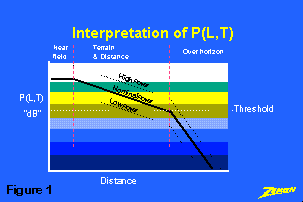 Even with the 90% of time availability requirement, the results in Charlotte were better than predicted. UHF VSB
results were excellent; the percentage of sites served exceeded NTSC at all distances. We conclude that UHF VSB can duplicate VHF NTSC, except where an entire area is over the horizon or heavily shaded (> 35 dB shading at the edge of service area). To explore this further, we look at a P(L, T) curve and the geographical
variations in reception.
Even with the 90% of time availability requirement, the results in Charlotte were better than predicted. UHF VSB
results were excellent; the percentage of sites served exceeded NTSC at all distances. We conclude that UHF VSB can duplicate VHF NTSC, except where an entire area is over the horizon or heavily shaded (> 35 dB shading at the edge of service area). To explore this further, we look at a P(L, T) curve and the geographical
variations in reception.
II. Interpretation of P(L,T)
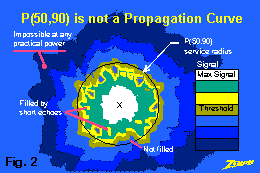 If T is large (e.g. 90% of time, as it is for digital broadcast predictions), then we are not relying on time-varying phenomena (refraction, diffraction) to carry the signal over-horizon. The resultant curve shows mainly location variations, during the worst 10% of time periods, and is expected to fall off rapidly at the horizon. The curve in Figure 1 has three parts. The near-field part (within about 10 miles) reflects relatively constant field strength and nearly uniform line-of sight conditions. The central part of the curve shows both decreasing field strength and the statistical results of terrain shielding in small areas. The third part of the curve represents over-the-horizon fall-off in the signal. Figure 2 shows a hypothetical service area that gives rise to this kind of curve.
If T is large (e.g. 90% of time, as it is for digital broadcast predictions), then we are not relying on time-varying phenomena (refraction, diffraction) to carry the signal over-horizon. The resultant curve shows mainly location variations, during the worst 10% of time periods, and is expected to fall off rapidly at the horizon. The curve in Figure 1 has three parts. The near-field part (within about 10 miles) reflects relatively constant field strength and nearly uniform line-of sight conditions. The central part of the curve shows both decreasing field strength and the statistical results of terrain shielding in small areas. The third part of the curve represents over-the-horizon fall-off in the signal. Figure 2 shows a hypothetical service area that gives rise to this kind of curve.
Near the transmitter, margin is high enough that every receiver, including any with an indoor antenna, receives a strong signal. Further out, as the signal level drops, we see the effects of topography, where some shaded regions are filled by short-delay echoes from surrounding terrain. Nearer the edge of the service area, some of these spots are not filled adequately. In some cases, a rise in terrain may give reception beyond the local depression; in other cases, no further reception is possible at greater distances. The limit of the service area is defined where 50% of the locations on the outer circle have adequate reception 90% of the time. Note that, although the curve does not indicate field strength directly, it is strongly correlated to field strength, as verified by the Charlotte test results. Increasing the transmitter power therefore moves the curve in Figure 1 upward, which predicts increased fill of some of the marginal spots and also predicts improved indoor reception. The extension beyond the horizon, however, is minimal with increased power, and increased
antenna height or a fill-in transmitter works better.
III. P(L,T) and the Radials
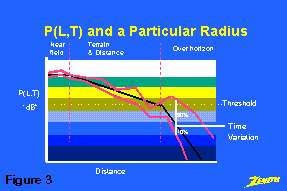 Figure 3 shows a particular radial for the hypothetical service area. Note that this radial has certain weak and strong spots, but the P(L,T) curve depends on averaging all the radials, based on measurements which will be exceeded 90% of the time. Figure 4 and Figure 5 show examples of the radial topography in Charlotte. Figure 6 shows how the statistics for all the hypothetical radials straddle the P(L,T) curve, so that the service radius is defined at the distance where 50% of locations are above threshold. Note again that transmitter power can be adjusted to reach the horizon with the P(50, 90) circle, but service beyond the horizon is difficult to improve this way.
Figure 3 shows a particular radial for the hypothetical service area. Note that this radial has certain weak and strong spots, but the P(L,T) curve depends on averaging all the radials, based on measurements which will be exceeded 90% of the time. Figure 4 and Figure 5 show examples of the radial topography in Charlotte. Figure 6 shows how the statistics for all the hypothetical radials straddle the P(L,T) curve, so that the service radius is defined at the distance where 50% of locations are above threshold. Note again that transmitter power can be adjusted to reach the horizon with the P(50, 90) circle, but service beyond the horizon is difficult to improve this way.
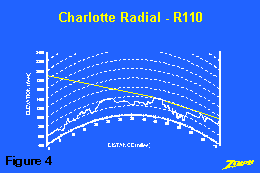
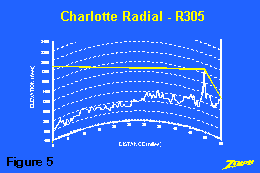
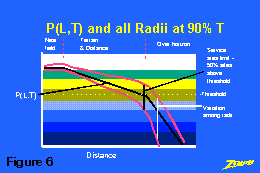
IV. Interpretation of P(L,T) and Charlotte Results
We conclude that many local shaded areas within the horizon are filled by short-time echoes, as measured at
Charlotte. For NTSC, this is seen as smeary or distorted pictures, rather than a distinct ghost image. For 8-VSB reception, these conditions are easily corrected by the equalizer. The equalizer in the prototype 8-VSB receiver was more than adequate in Charlotte. However, we will see below that echoes from a single-frequency network (SFN) or on-channel repeater are worse than terrain effects, and this can be a problem for COFDM as well as 8-VSB.
For service extension, we conclude that coverage (short of the horizon) can be improved somewhat by better filling,
using either higher power or other techniques such as circular polarization. Indoor reception is subject to attenuation due
to the building and due to low antenna height. It is also subject to varying short term ghosts, and to. rapidly varying signal level and occasional deep attenuation as people move around the room or traffic goes by. The Charlotte tests indicated rapid signal level variations to be an important concern in receiver design, having a greater effect than the ghosting itself. Greater power helps to increase the signal in these momentary fades; circular polarization should also help in this regard.
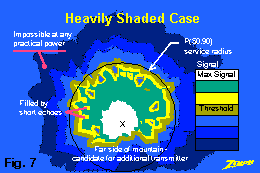 Looking at the way terrain affects the coverage, we can also see that repeaters are not useful for the many tiny
scattered shaded areas that make up the P(L,T) statistics within the horizon. Additional transmitters are useful in two cases: over the horizon, and in heavily shaded areas (e.g. the back side of a mountain). Figure 7 illustrates such a
case, where a large topographical feature prevents the actual service from following the predicted P(L,T) statistics.
Looking at the way terrain affects the coverage, we can also see that repeaters are not useful for the many tiny
scattered shaded areas that make up the P(L,T) statistics within the horizon. Additional transmitters are useful in two cases: over the horizon, and in heavily shaded areas (e.g. the back side of a mountain). Figure 7 illustrates such a
case, where a large topographical feature prevents the actual service from following the predicted P(L,T) statistics.
V. Coverage Extension Methods
We will consider three coverage extension methods:
- Single Frequency Networks (SFNs)
- On-Channel Repeaters
- Translators
VI. Single Frequency Networks
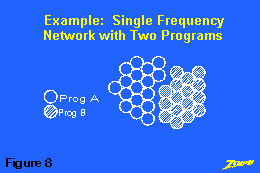 Single-frequency networks are characterized by the use of a large number of lower-power transmitters, all on the same frequency, and a resultant introduction of deliberately produced echoes. Figure 8 shows two single-frequency networks serving adjacent areas.
Single-frequency networks are characterized by the use of a large number of lower-power transmitters, all on the same frequency, and a resultant introduction of deliberately produced echoes. Figure 8 shows two single-frequency networks serving adjacent areas.
This illustrates that there is still need for coordination of co-channel radiation, and perhaps other taboos as well. In addition, operating such a system in the same band as NTSC is not generally possible. NTSC cannot tolerate transmission with deliberately introduced ghosts, and therefore cannot use an SFN. An SFN for digital service, however, will introduce an area of taboo interference around each small transmitter, which will not be tolerable to nearby NTSC receivers.
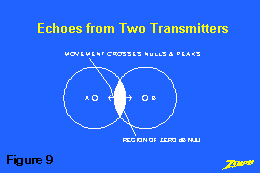
Assuming that the SFN can be isolated in frequency to protect existing service, there are other problems to be addressed. In particular, short-delay zero dB echoes must be avoided. This would be a problem with any modulation (COFDM or VSB). It constrains signal timing and station spacing. Figure 9 and Figure 10 show two views of the region of zero-dB echoes between two SFN transmitters.
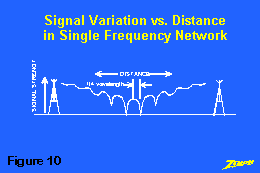
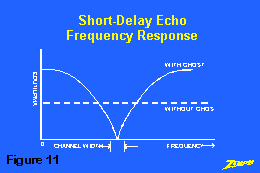 The simultaneous short delay difference and 0-dB signal ratio can produce a wide null in the frequency domain, as shown in Figure 11. This cannot be tolerated by any transmission system. Offset of transmitter timing or location (probably in a randomized fashion?) is needed to prevent this. Such offsets introduce non-zero delay echoes, which use up some of the guard interval in COFDM, or deliberately load the equalizer in 8-VSB. In addition, in order to be completely safe, we should consider variations with time, which may move the crossover
of signal strength to different locations depending on fading of one transmitter or the other.
The simultaneous short delay difference and 0-dB signal ratio can produce a wide null in the frequency domain, as shown in Figure 11. This cannot be tolerated by any transmission system. Offset of transmitter timing or location (probably in a randomized fashion?) is needed to prevent this. Such offsets introduce non-zero delay echoes, which use up some of the guard interval in COFDM, or deliberately load the equalizer in 8-VSB. In addition, in order to be completely safe, we should consider variations with time, which may move the crossover
of signal strength to different locations depending on fading of one transmitter or the other.
If we use a central transmitter with repeaters instead of an SFN, the problem is reduced somewhat because of the deliberate lower power of the repeater; it is still necessary to avoid having the signal strengths of the main and repeater transmitters to be equal at locations where the delay is also equal. Because of time and location variability, there should be some additional safety margin built in to prevent this zero dB condition during fades.
VII. Echo with Multiple Nulls in Channel - Noise Enhancement
- COFDM with an SFN
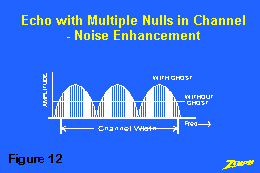 Assuming that short-term echoes can be avoided, there's still an effect of reduced noise margin ("noise enhancement") caused by echoes. This is easiest to see in the COFDM spectrum with ghosts (Figure 12). The effect of the ghost is to reduce some of the COFDM carriers below threshold. If the data on these carriers cannot be entirely replaced by the error correction coding, then the transmitted power must be increased to bring enough carriers above threshold. COFDM systems have been measured to require increases of up to 12 dB in signal strength for this reason.
Assuming that short-term echoes can be avoided, there's still an effect of reduced noise margin ("noise enhancement") caused by echoes. This is easiest to see in the COFDM spectrum with ghosts (Figure 12). The effect of the ghost is to reduce some of the COFDM carriers below threshold. If the data on these carriers cannot be entirely replaced by the error correction coding, then the transmitted power must be increased to bring enough carriers above threshold. COFDM systems have been measured to require increases of up to 12 dB in signal strength for this reason.
- VSB with Repeaters
If we use VSB instead of COFDM, and a central transmitter with repeaters instead of an SFN, the most severe effect is in any back-propagation area from the repeater into the main transmitter coverage. 8-VSB can tolerate up to -3 dB echoes, stronger in some cases. Noise enhancement for 8-VSB measures 3.64 dB worst case with the ATTC test ensembles. In addition, problems can be alleviated with a small antenna directivity ( on the order of 3 dB ). In this case, it is not necessary to increase transmitter power, partly because of the ratio of central to repeater power.
With few, low-power repeaters, the total area affected by deliberate echoes can be small compared to an SFN. However, the use of repeaters gets progressively more difficult as the terrain shielding decreases. A proper study should use P(50,90) for the desired signal and P(50,10) for the undesired signal. This implies that from time to time the signals may reverse their relative dominance at locations near the nominal equal-signal region, if repeater placement and power is not carefully chosen.
VIII. On Channel Repeater Problems
- Stability
Independent of the reception problems caused by echoes, the repeater itself is subject to implementation difficulties due to feedback from the repeater to its own receiver. This may take the form of direct feedback and oscillation, or the introduction of "twice around" ghosts. The high isolation needed has been demonstrated at microwave frequencies, but is more problematic at UHF, and probably impossible at VHF.
- Receive-Process-Retransmit Delay
If the repeater does not correct errors or ghosts in the received signal, its output will suffer an equivalent noise enhancement due to accumulation of ghosts (eye closure) and noise.
An 8-VSB reprocessor will use an estimated 200 microseconds for error processing and remodulation of the signal. The 8-VSB prototype receiver (19 Mbits/s, 2/3 rate trellis) had a 24 microsecond equalizer length, easily expandable (but with some complexity/cost impact). Note that the equalizer needed for use with the reprocessing repeater is about 10 times the length needed for terrain induced ghosts.
The receive-process-retransmit delay for an 8K-carrier COFDM system would be 84,000 microseconds (1 frame minimum). [These numbers are derived from an 8 MHz DVB system, scaled to 6 MHz, with data rate of 18 Mbits/s, and 2/3 rate trellis code. This system uses 8,000 64-QAM carriers, 6,817 useful for payload.]
The guard interval for this system is 37 microseconds, and is fixed by the system design, that is it cannot be expanded by changing the receiver design, as is possible with 8-VSB.
The 2k-carrier version of this system has a frame delay of 21,000 microseconds and a guard interval of 9 microseconds, also fixed by the system design.
It appears that only receive-retransmit without error reprocessing is feasible with COFDM. On the other hand, reprocessing delays are feasible with 8-VSB, but need coordination with receiver design.
One might consider using synchronized transmitters instead, but this results in all the requirements for signal distribution
infrastructure, as in an SFN.
IX. Translator Solution
If, instead of rebroadcasting on the same frequency, we employ translators to different channels, we avoid the above
problems entirely. The one awkward aspect of translators for analog service has been the need for the viewer to find the program on the translator frequency. For digital service, this is not a problem because the digital receiver finds the program source automatically, without viewer intervention. Tuning is by program/provider ID, not by channel number.
Translators also are more feasible in the digital service because relaxed ATV taboos ease allocation, and allocation
of low-power translators is less stringent than allocation of high-power central transmitters.
Translators give no interference to their main signal; they have simple antenna requirements and stable operation without undesired feedback.
Translator location is not constrained by lack of topographical shielding -coverage can be tailored even in flatlands.
Translators minimize technical requirements and cost. The site antennas and their shielding are simple. Even a consumer-grade receiver is sufficient to correct incoming ghosts and errors and prepare a clean signal for retransmission. The reprocessed signal provides a maximum reception margin and coverage for a given power output.
X. Low Power and Secondary Allocations
The opportunity exists now for planning, not only for translators and coverage extension, but for other uses, for
example studio-transmitter links. A low power directional 8-VSB transmitter can be operated in the UHF band for this purpose without affecting broadcast reception in the region. This is also the time to factor in the possibility of retaining existing LPTV allocations, or finding an acceptable substitute, such as bit-stream sharing on a central transmitter.
XI. Conclusion
8-VSB coverage extension is needed only in extreme cases (where NTSC would also fail). The 8-VSB receiver will work
with on-channel repeaters, but repeaters are difficult, and may be practical only at high UHF with heavy shading.
Translators offer the best solution in terms of performance and ease of implementation.
References:
- Single Carrier VSB Digital Television Transmission, Single-Frequency Networks, and Repeater Systems, W. Bretl and R. Citta, IEEE Transactions on Consumer Electronics, February 1996
- Analysis of ATV Transmission Subsystem Field Test Data, W. Zou, Y. Wu and M. Guillet, IEEE Transactions
on Broadcasting, March 1996
The Authors
Richard Citta obtained his BSEE degree in 1969 from the Illinois Institute of Technology and his MSEE degree in 1971
from the University of Washington. He is currently a manager in the Electronics Systems Research and Development Department of Zenith Electronics corporation. His group's activities are concentrated on development of high definition television and digital transmission systems. He holds 61 US patents with 3 patents pending. In 1988 he was recipient of the Robert Adler award, Zenith's highest award for technical achievement.
Wayne Bretl is a Staff Consulting Engineer in the Electronic Systems R&D department of Zenith Electronics.
He received the BSEE from Illinois Institute of Technology in 1966. He holds 12 patents in television and related areas. He
is a member of IEEE, SMPTE, and AES, and represents Zenith in a number of professional and industry associations.
 Even with the 90% of time availability requirement, the results in Charlotte were better than predicted. UHF VSB
results were excellent; the percentage of sites served exceeded NTSC at all distances. We conclude that UHF VSB can duplicate VHF NTSC, except where an entire area is over the horizon or heavily shaded (> 35 dB shading at the edge of service area). To explore this further, we look at a P(L, T) curve and the geographical
variations in reception.
Even with the 90% of time availability requirement, the results in Charlotte were better than predicted. UHF VSB
results were excellent; the percentage of sites served exceeded NTSC at all distances. We conclude that UHF VSB can duplicate VHF NTSC, except where an entire area is over the horizon or heavily shaded (> 35 dB shading at the edge of service area). To explore this further, we look at a P(L, T) curve and the geographical
variations in reception. If T is large (e.g. 90% of time, as it is for digital broadcast predictions), then we are not relying on time-varying phenomena (refraction, diffraction) to carry the signal over-horizon. The resultant curve shows mainly location variations, during the worst 10% of time periods, and is expected to fall off rapidly at the horizon. The curve in Figure 1 has three parts. The near-field part (within about 10 miles) reflects relatively constant field strength and nearly uniform line-of sight conditions. The central part of the curve shows both decreasing field strength and the statistical results of terrain shielding in small areas. The third part of the curve represents over-the-horizon fall-off in the signal. Figure 2 shows a hypothetical service area that gives rise to this kind of curve.
If T is large (e.g. 90% of time, as it is for digital broadcast predictions), then we are not relying on time-varying phenomena (refraction, diffraction) to carry the signal over-horizon. The resultant curve shows mainly location variations, during the worst 10% of time periods, and is expected to fall off rapidly at the horizon. The curve in Figure 1 has three parts. The near-field part (within about 10 miles) reflects relatively constant field strength and nearly uniform line-of sight conditions. The central part of the curve shows both decreasing field strength and the statistical results of terrain shielding in small areas. The third part of the curve represents over-the-horizon fall-off in the signal. Figure 2 shows a hypothetical service area that gives rise to this kind of curve.  Figure 3 shows a particular radial for the hypothetical service area. Note that this radial has certain weak and strong spots, but the P(L,T) curve depends on averaging all the radials, based on measurements which will be exceeded 90% of the time. Figure 4 and Figure 5 show examples of the radial topography in Charlotte. Figure 6 shows how the statistics for all the hypothetical radials straddle the P(L,T) curve, so that the service radius is defined at the distance where 50% of locations are above threshold. Note again that transmitter power can be adjusted to reach the horizon with the P(50, 90) circle, but service beyond the horizon is difficult to improve this way.
Figure 3 shows a particular radial for the hypothetical service area. Note that this radial has certain weak and strong spots, but the P(L,T) curve depends on averaging all the radials, based on measurements which will be exceeded 90% of the time. Figure 4 and Figure 5 show examples of the radial topography in Charlotte. Figure 6 shows how the statistics for all the hypothetical radials straddle the P(L,T) curve, so that the service radius is defined at the distance where 50% of locations are above threshold. Note again that transmitter power can be adjusted to reach the horizon with the P(50, 90) circle, but service beyond the horizon is difficult to improve this way. 


 Looking at the way terrain affects the coverage, we can also see that repeaters are not useful for the many tiny
scattered shaded areas that make up the P(L,T) statistics within the horizon. Additional transmitters are useful in two cases: over the horizon, and in heavily shaded areas (e.g. the back side of a mountain). Figure 7 illustrates such a
case, where a large topographical feature prevents the actual service from following the predicted P(L,T) statistics.
Looking at the way terrain affects the coverage, we can also see that repeaters are not useful for the many tiny
scattered shaded areas that make up the P(L,T) statistics within the horizon. Additional transmitters are useful in two cases: over the horizon, and in heavily shaded areas (e.g. the back side of a mountain). Figure 7 illustrates such a
case, where a large topographical feature prevents the actual service from following the predicted P(L,T) statistics. Single-frequency networks are characterized by the use of a large number of lower-power transmitters, all on the same frequency, and a resultant introduction of deliberately produced echoes. Figure 8 shows two single-frequency networks serving adjacent areas.
Single-frequency networks are characterized by the use of a large number of lower-power transmitters, all on the same frequency, and a resultant introduction of deliberately produced echoes. Figure 8 shows two single-frequency networks serving adjacent areas. 

 The simultaneous short delay difference and 0-dB signal ratio can produce a wide null in the frequency domain, as shown in Figure 11. This cannot be tolerated by any transmission system. Offset of transmitter timing or location (probably in a randomized fashion?) is needed to prevent this. Such offsets introduce non-zero delay echoes, which use up some of the guard interval in COFDM, or deliberately load the equalizer in 8-VSB. In addition, in order to be completely safe, we should consider variations with time, which may move the crossover
of signal strength to different locations depending on fading of one transmitter or the other.
The simultaneous short delay difference and 0-dB signal ratio can produce a wide null in the frequency domain, as shown in Figure 11. This cannot be tolerated by any transmission system. Offset of transmitter timing or location (probably in a randomized fashion?) is needed to prevent this. Such offsets introduce non-zero delay echoes, which use up some of the guard interval in COFDM, or deliberately load the equalizer in 8-VSB. In addition, in order to be completely safe, we should consider variations with time, which may move the crossover
of signal strength to different locations depending on fading of one transmitter or the other.  Assuming that short-term echoes can be avoided, there's still an effect of reduced noise margin ("noise enhancement") caused by echoes. This is easiest to see in the COFDM spectrum with ghosts (Figure 12). The effect of the ghost is to reduce some of the COFDM carriers below threshold. If the data on these carriers cannot be entirely replaced by the error correction coding, then the transmitted power must be increased to bring enough carriers above threshold. COFDM systems have been measured to require increases of up to 12 dB in signal strength for this reason.
Assuming that short-term echoes can be avoided, there's still an effect of reduced noise margin ("noise enhancement") caused by echoes. This is easiest to see in the COFDM spectrum with ghosts (Figure 12). The effect of the ghost is to reduce some of the COFDM carriers below threshold. If the data on these carriers cannot be entirely replaced by the error correction coding, then the transmitted power must be increased to bring enough carriers above threshold. COFDM systems have been measured to require increases of up to 12 dB in signal strength for this reason.